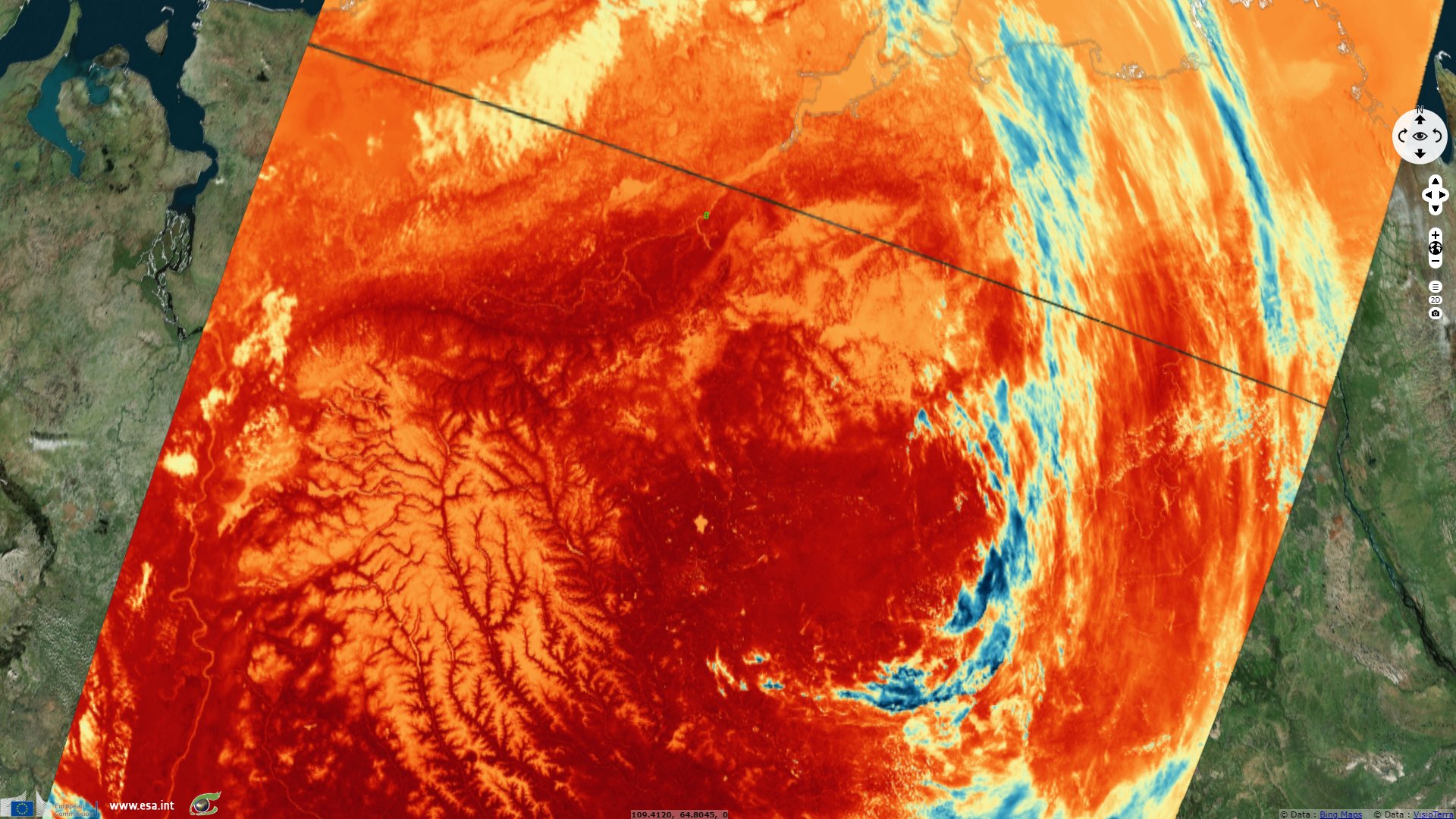Siberia experiences a six-months heatwave, Russia
Sentinel-3 SLSTR RBT acquired on 24 April 2019 at 03:56:03 UTC
...
Sentinel-3 SLSTR RBT acquired on 24 June 2020 at 01:01:03 UTC
Sentinel-5P TROPOMI AER_AI & CO acquired on 24 June 2020 from 02:23:25 to 05:48:25 UTC
Sentinel-2 MSI acquired on 25 June 2020 from 01:06:51 to 02:45:51 UTC
...
Sentinel-3 SLSTR RBT acquired on 24 June 2020 at 01:01:03 UTC
Sentinel-5P TROPOMI AER_AI & CO acquired on 24 June 2020 from 02:23:25 to 05:48:25 UTC
Sentinel-2 MSI acquired on 25 June 2020 from 01:06:51 to 02:45:51 UTC
Keyword(s): Polar, cryosphere, heatwave, ice, snow, wildfire, Siberia, Russia
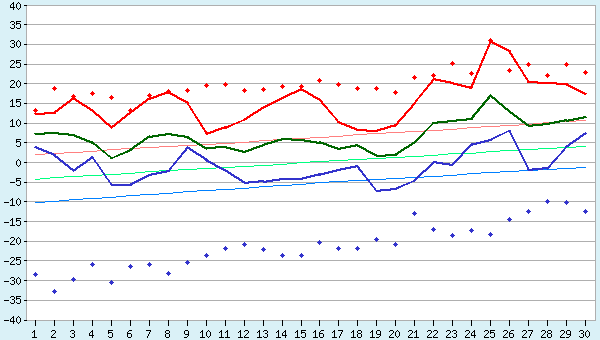
April 2020 minimum, medium, maximum air temperature in Boguchany are represented on the chart by solid lines corresponding to blue, green and red colors. 1885-2020 mean April values are shown in solid thin lines. Absolute highs and temperature lows for each day of April are marked by greasy points corresponding to red and blue - Source: pogodaiklimat.ru.
Siberia experiences a lasting heatwave. In article published in Mongabay on 19 May 2020, Elizabeth Claire Alberts reported: "A few hundred miles south of the Arctic Circle, the small town of Boguchany in Siberia, Russia, had its hottest April on record. On April 25, the temperature soared to 31° Celsius, even though it should be much cooler at this time of the year."
"'That’s not only a new record anomaly for Russia. That’s the largest January to April anomaly ever seen in any country’s national average,' Robert Rohde of the nonprofit climate research group Berkeley Earth said in a tweet." according to the Moscow Times.
One month later, the Moscow Times alerted about another broken record: "At least one Siberian town above the Arctic Circle, Khatanga, broke its previous single-day record of 12 degrees Celsius for May 23 when the temperature hit 25.4 last Saturday."
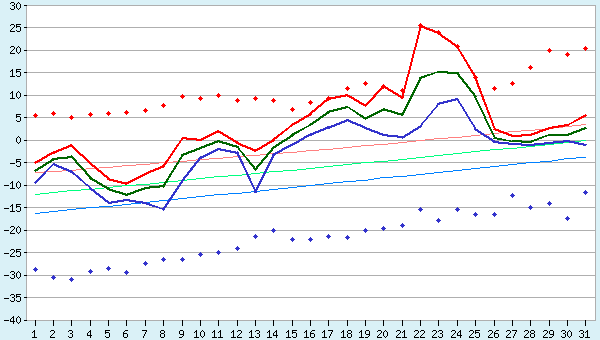

May 2020 minimum, medium, maximum air temperature in Khatanga are represented on the chart by solid lines corresponding to blue, green and red colors. 1885-2020 mean May values are shown in solid thin lines. Absolute highs and temperature lows for each day of May are marked by greasy points corresponding to red and blue - Source: pogodaiklimat.ru.
On June 5, 2020, Rob Picheta wrote for CNN: "Two thirds of Russia sits on permafrost, which is degrading rapidly, puncturing places with giant sinkholes. It follows a remarkably warm winter in Russia, which would usually be blanketed in snow at the start of a year. Instead, it saw the hottest winter in the 140-year history of meteorological observations".
According to the Moscow Times by the end of May, "Weather experts say temperatures in the region have been between 3 degrees Celsius and 6 degrees Celsius above average since January", even 10°C warmer than average in some parts of Siberia.
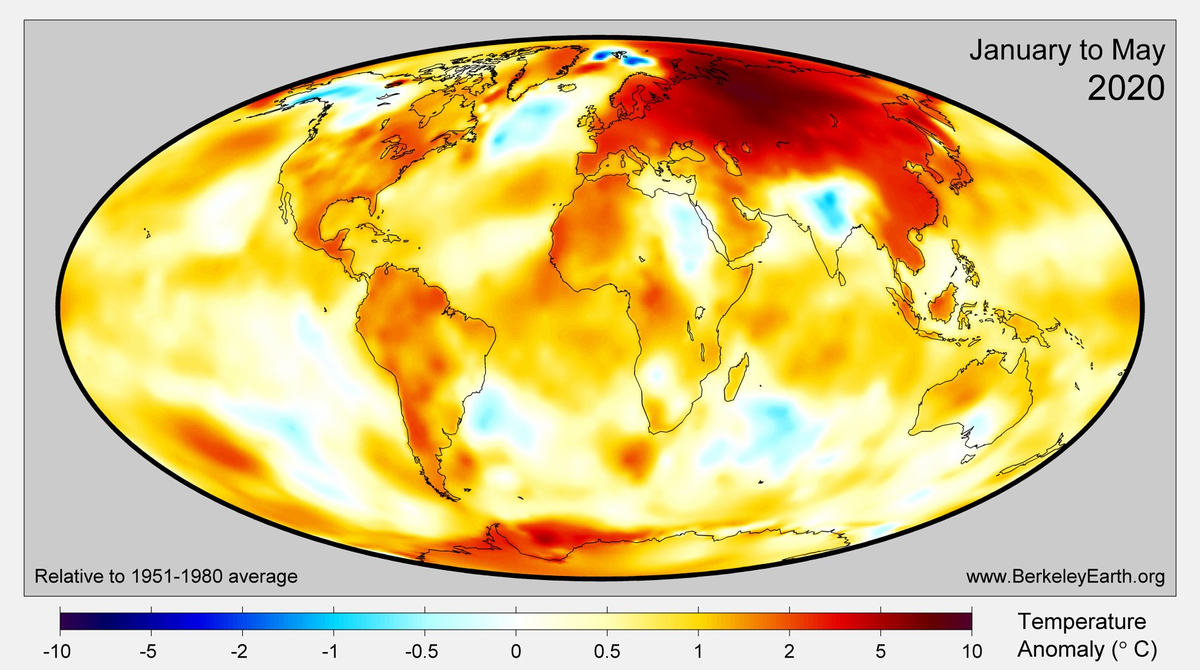

Surface air temperature anomaly for January to May 2020 relative to the average for 1951-2080 - Credit: Robert Rohde, Berkeley Earth.
According to a preliminary reading, 38°C were measured on Saturday in Verkhoiansk, Siberia. If this figure were to be confirmed, it would represent the temperature record so far north of the Arctic Circle but also the highest temperature ever recorded north of the Arctic Circle, tweeted Etienne Kapikian, weather forecaster at Meteo France. The temperature of 38°C is 17°C above normal for this time of year.
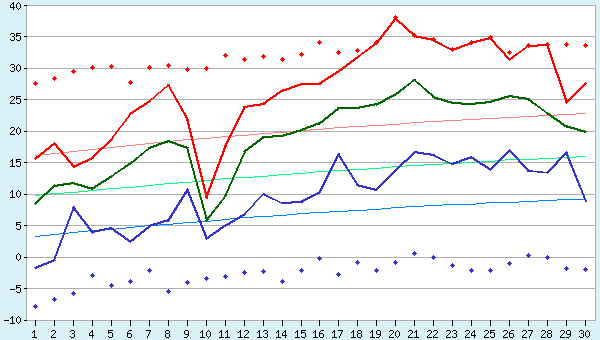

June 2020 minimum, medium, maximum air temperature in Verhoyansk are represented on the chart by solid lines corresponding to blue, green and red colors. 1885-2020 mean June values are shown in solid thin lines. Absolute highs and temperature lows for each day of June are marked by greasy points corresponding to red and blue - Source: pogodaiklimat.ru.
A climate bulletin from the Copernicus Climate Change Service analysed: "Boreal spring was marked by highly anomalous temperatures over Siberia, which reached close to 10°C above the 1981-2010 average over the lower reaches of the Ob and Yenisei rivers in the north-west of the region." "An area of western Siberia from 55°N to 75°N and from 60°E to 120°E was examined in detail; this revealed that, in this area, May 2020 was the warmest month in our data record. For ERA5, the largest anomaly within this region was 10°C above average. The green circle shows the location of Tarko-Sale, the weather station measuring the largest anomaly, at 8.8°C above average. At the same location, ERA5 gives a value of 9.2°C above average".


"Running twelve-month averages of global-mean and European-mean surface air temperature anomalies relative to 1981-2010, based on monthly values from January 1979 to May 2020. The darker coloured bars are the averages for each of the calendar years from 1979 to 2019. Data source: ERA5." - Source: Copernicus Climate Change Service/ECMWF
Elizabeth Claire Alberts related in Mongabay: "Anton Beneslavskiy, a forest fire and climate emergency expert with Greenpeace International in Moscow, said it’s very concerning that fires were burning in Siberia this early in the season. 'This year’s fire season has started extremely early, and fires became intensive from the very beginning,' Beneslavskiy told Mongabay in an email. 'That means a possible ‘long fire summer’ with a lot of forest destruction.'"
"Last year, fires swept through 15 million hectares of forest in Siberia, although official numbers were underestimated, according to Greenpeace International. 'It was definitely one of the most disastrous fire seasons,' Beneslavskiy said, adding that he didn’t see the fire situation improving in Siberia anytime soon."
Kristina Dahl, senior climate scientist at the Union of Concerned Scientists, said to Mongabay: "'The region is home to one of the world’s largest high-latitude forests and much of the region’s land is permafrost,' Dahl said. 'Both forests and permafrost store enormous amounts of carbon. So when they burn or thaw, carbon dioxide is released into the atmosphere, which then causes further warming.'"



